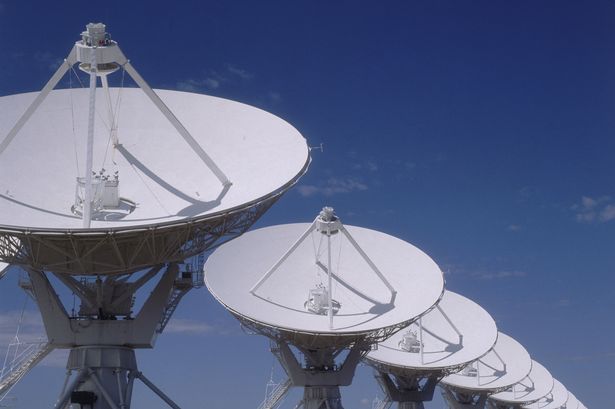Task is coordinated effort between secretly supported firm and New Mexico observatory
Space experts will clear the whole sky for indications of extraterrestrial life just because, utilizing 28 monster radio telescopes in an exceptional chase for outsider civilisations.
The task is a joint effort between the secretly financed Seti Institute and the Very Large Array observatory in New Mexico, one of the world’s most impressive radio observatories. Increasing continuous access to all the information assembled by VLA is viewed as a significant overthrow for researchers chasing extraterrestrial lifeforms and a sign that the field has “gone mainstream”.
Ordinary space science tasks will proceed at the VLA, which was highlighted in the 1997 film Contact, however under the new game plan all information will be copied and bolstered through a devoted supercomputer that will look for blares, cackles or different marks of far off innovation.
“The VLA is being used for an all-sky survey and we kind of go along for the ride,” said Andrew Siemion, executive of the Berkeley Seti focus. “It allows us to in parallel conduct a Seti survey.”
“Determining whether we are alone in the universe as technologically capable life is among the most compelling questions in science, and our telescopes can play a major role in answering it,” said Tony Beasley, executive of The National Radio Astronomy Observatory, which runs the VLA.
The primary period of the undertaking, putting in new links, has been supported by John Giannandrea, a senior Apple official and trustee of the Seti Institute, and Carol Giannandrea.
The VLA venture is one of a flood of up and coming Seti activities portrayed out at the American Association for the Advancement of Science (AAAS) gathering in Seattle on Friday.
Jill Tarter, an emeritus analyst at the Seti Institute, gave refreshes on Panoseti, a proposed observatory in the model phase of improvement intended to constantly watch an enormous segment of the sky. In the case of financing is verified, Panoseti will include two geodesic vaults canvassed down the middle meter focal points, giving it the presence of a goliath pair of creepy crawly eyes.
The capacity to at the same time watch a huge territory of sky would make it interestingly fit to spotting transient signs, for example, the glimmer of a far off incredible laser. “To catch that kind of thing you really do want to be looking when the signal comes your way,” said Tarter in front of their discussion.
The veteran Seti researcher said the field had been supported in the previous decade by the revelation that about a fifth of stars have planets in the “habitable zone”.
“Now that there might be more habitable real estate out there than we ever imagined early on … it seems to make this next question about intelligent life more realistic,” they said. “It’s not as far on the fringes as it once was – it’s almost mainstream.”
Others are chasing for less canny assortments of outsider life. Talking at a similar session at AAAS, Victoria Meadows, who drives Nasa’s Virtual Planetary Laboratory at the University of Washington, depicted perceptions arranged with the James Webb Space Telescope, planned to dispatch one year from now.
Three Earth-sized planets circling a cool, diminish star called Trappist-1 in the heavenly body of Aquarius will be high up on the hit list. PC models recommend the Trappist-1 framework is among the most encouraging for discovering planets with environments and temperatures that would empower fluid water to exist superficially.
“The James Webb Telescope will be able to tell us whether they have atmospheres like the Earth or Venus,” said Meadows. “It gives us our first real chance to search for gases given off by life on another planet. We’re basically going to get to study Earth’s cousins.”
Siemion likewise reported the second tranche of results from the $100m (£76m) Breakthrough Listen Initiative: no outsider transmissions have been recognized up until now.
The most recent study, the most extensive to date of radio outflows, incorporated the principal search of the “Earth transit zone”. The travel zone search focused on 20 stars in positions where the speculative occupants of these heavenly bodies would have the option to watch the Earth’s shadow glinting over the sun. This technique for identification has permitted space experts to recognize a large number of exoplanets and decide if their conditions are possibly livable.
“This turns that around and says, ‘What if some other civilisation were watching our sun?’” said Siemion.
In the event that there is, it is either observing discreetly or viewing from a portion of the other 200bn stars in the Milky Way.
As the most recent innovation progresses bring researchers a bit nearer to responding to the subject of whether anybody or anything is out there, there are still issues to be resolved over best practice if an outsider civilisation is recognized.
Stephen Hawking cautioned against endeavoring any type of contact, recommending the result for people would not really be acceptable. Siemion opposes this idea. “Personally I think we absolutely should and I think without a doubt, we would,” they said. “Part of being human is wanting to reach out into the unknown and wanting to reach out and make connections.”
Notice
They are less definitive about what Earth’s message ought to be, in any case. “I don’t know … I spend absolutely zero time thinking about that,” he said. “I guess I would just say, ‘Hello’.”
Disclaimer: The views, suggestions, and opinions expressed here are the sole responsibility of the experts. No State Today USA journalist was involved in the writing and production of this article.
